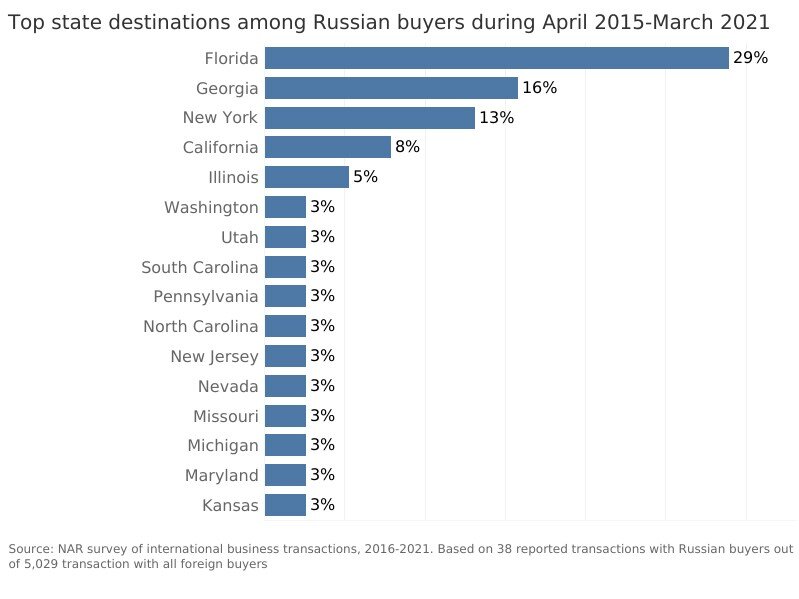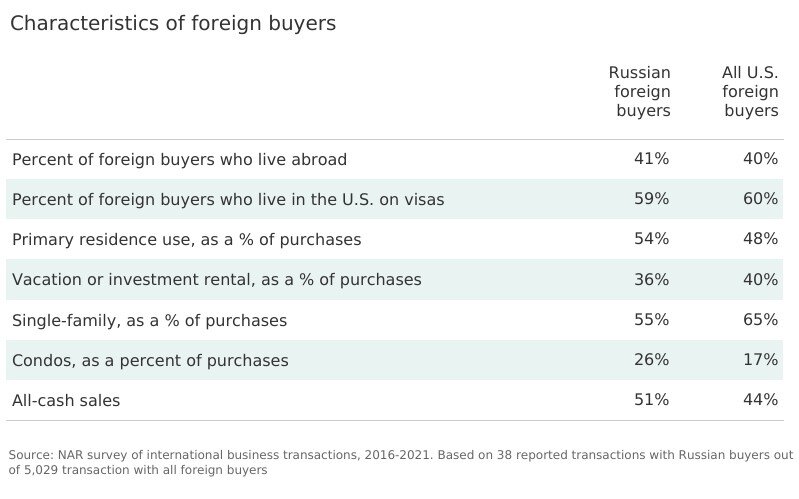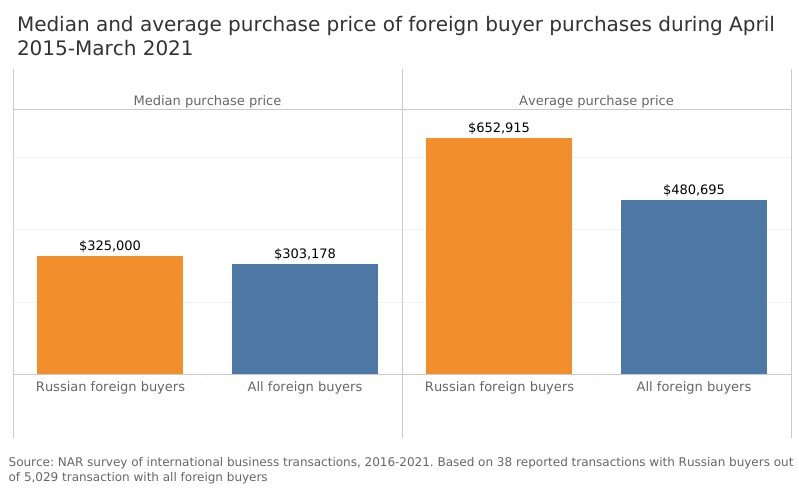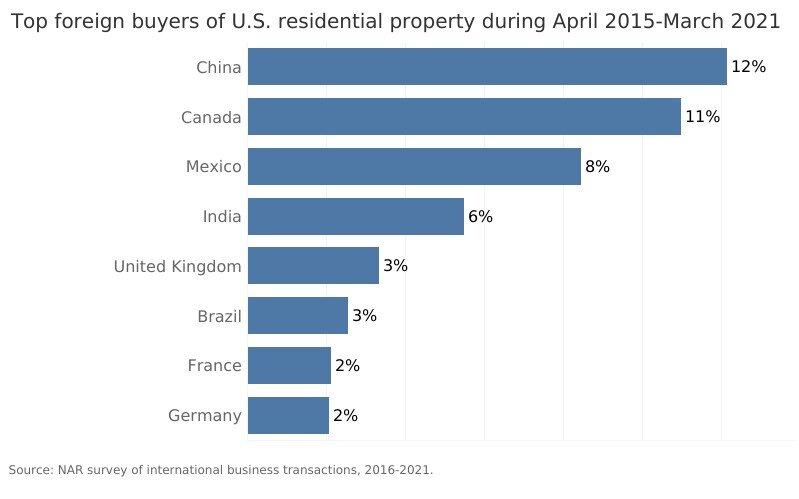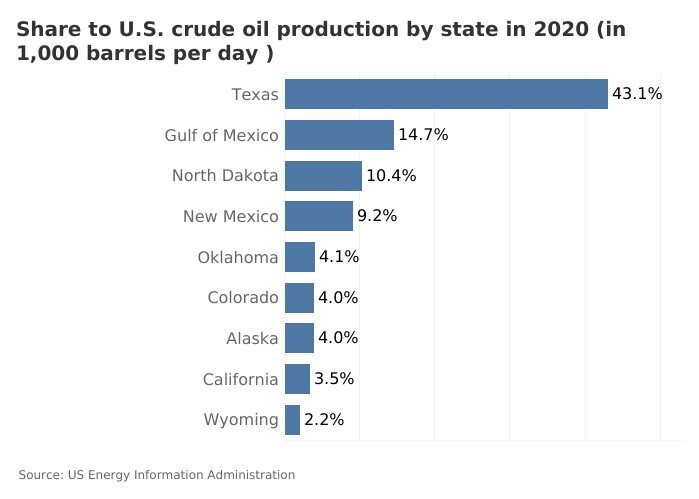Residential Real Estate News

NAR Says Russian Invasion Into Ukraine to Have Minimal Impact on U.S. Housing Markets
Residential News » Kiev Edition | By Michael Gerrity | March 8, 2022 9:04 AM ET
Florida historically has the most foreign Russian property buyers in the U.S.
The National Association of Realtors Senior Research Economist Scholastica Gay Cororaton is reporting this week that any decline in international real estate transactions from Russia's invasion of Ukraine will have little direct impact on the U.S. housing market.
According to NAR's 2021 International Transactions in U.S. Residential Real Estate Report, Russian foreign buyers account for less than 1% of foreign buyer purchases, and overall, foreign buyers account for about 2% of existing-home sales.
Moreover, the decline in foreign demand will ease supply constraints for domestic buyers. And in the short-term, with escalating geopolitical tension, the U.S. Treasury Note and the 30-year mortgage rate may not move in lockstep with the federal funds rate as investors reallocate their portfolios toward the U.S. Treasuries, as happened last week when the 30-year fixed mortgage rate fell to 3.76%.
However, should oil prices be sustained above the $100/barrel level, the deeper effects of higher inflation, bigger future interest rate adjustments, weaker global currencies relative to the U.S., and slower global growth creates significant downside risks to the housing market.
Russia: less than 1% of foreign buyers
Cororaton further states that Russia has little direct impact on the U.S. real estate market as it accounted for less than 1% (0.8%) of all foreign buyers who purchased U.S. residential property during April 2015-March 2021, according to data from NAR's survey of foreign buyer transactions of its members with about 5,000 respondents. Moreover, total foreign buyer purchases account for just 1.8% of total existing-home sales.
According to the NAR survey, Russian foreign buyers purchased properties during April 2015-March 2021 in Florida (29%), Georgia (16%), New York (13%), California (8%), and Illinois (5%).
Even in Florida, which had the most Russian purchases, they account for just 0.2% of Florida's total market during July 2020-June 2021, according to NAR's and Florida Realtor's Profile of International Residential Real Estate Activity in Florida.
Florida's major foreign buyers are Canadians, Latin Americans (Colombia, Argentina, Brazil, Venezuela, Mexico, Peru, and Chile), and Western Europeans (United Kingdom, France, Germany, and Italy). Russian buyers were more active in Bradenton-Sarasota, accounting for 6% of foreign buyer purchases in that area during July 2020-June 2021. However, Bradenton-Sarasota accounts for just 4% of Florida's foreign buyers, so total Russian purchases just made up 0.2% of the Florida market.
Russian foreign buyer statistics
According to NAR's surveys, 41% of Russian foreign buyers who purchased residential property lived abroad, and the majority already lived in the U.S. as visa holders (e.g., for work, as diplomats, students) when they purchased the property. This is about the same share as all U.S. foreign buyers. Because a majority of Russian foreign buyers reside in the U.S., 54%, purchased the property for use as a primary residence, and only 36% purchased the property for vacation use or to rent out.
Slightly more than half of Russian foreign buyer purchases were all-cash, and this is more likely of foreign buyers who lived abroad. Those who obtained mortgage financing are the buyers who reside in the United States and live here. However, there appears to be a preference for condos among Russian buyers, with 26% purchasing condos, compared to 17% among all foreign buyers.
Foreign buyers who live abroad tend to purchase condos, based on the characteristics of all foreign buyers. So, Russians living abroad may have difficulty making payments on their condo fees, but the overall impact on the condominium market will be small given the small share of Russian buyers to the housing market.
The median purchase price among Russian buyers was $325,000, just slightly higher than the median purchase price among all U.S. foreign buyers of $303,200. However, the average purchase price among Russian buyers was $652,915, compared to $480,695 among all foreign buyers, suggesting there were more high-end Russian buyers.
Canada, Brazilian, and Mexican foreign buyers less likely to be impacted than China and Europe
During April 2015 - March 2021, China, the United Kingdom, Germany, and France accounted for nearly 20% of U.S. foreign buyers. Canada accounted for 11% of U.S. foreign buyers, while Mexico and Brazil accounted for 11%.
With two-thirds of Europe's crude imports and 41% of EU's natural gas coming from Russia, the Western European economies face a looming energy crisis (i.e., a shortage of natural gas and high prices).
Meanwhile, China may also be impacted because of higher prices for wheat, corn, and sunflower oil, as it is the second largest country that Ukraine exports to. China and Europe account for nearly 20% of U.S. foreign buyers.
On the other hand, net oil producers like Canada, Brazil, Mexico, and Saudi Arabia won't be as hard hit by a protracted Russia-Ukraine political crisis.
Texas, North Dakota, and oil-producing states face growth upside
In the United States, the economies of oil-producing states face upside growth prospects as oil production is increased to beef up global supply: Texas, which produces 43% of U.S. crude oil, as well as the states of North Dakota, New Mexico, Oklahoma, Colorado, Alaska, and Wyoming.
More employment in these states will increase the demand for housing and push up home prices in these markets, concludes Cororaton.
Sign Up Free | The WPJ Weekly Newsletter
Relevant real estate news.
Actionable market intelligence.
Right to your inbox every week.
Real Estate Listings Showcase
Related News Stories
Residential Real Estate Headlines
- Las Vegas Area Home Prices Uptick 4.3 Percent Annually in March
- Single-Family Rent Growth in U.S. Trends Upward in 2025
- U.S. Mortgage Rates Tick Down Post Trump Tariffs Commencement
- President Trump's 'Liberation Day' Tariffs Potential Impact on the U.S. Housing and Mortgage Markets
- Baby Boomers Biggest Cohort of U.S. Home Buyers in 2025 as Millennials Decline
- U.S. Monthly Housing Payments Hit Record High in 2025
- U.S. Pending Home Sales Uptick in February
- Global Prime Residential Rent Slowdown Continued in Late 2024
- Ireland Home Price Inflation Hits 8 Year High in Early 2025
- Existing Home Sales in America Uptick in February
- Great Miami Area Residential Sales Decline 15 Percent Annually in February
- Mortgage Rates Uptick in Mid-March, Ending 9-Week Decline in U.S.
- World Property Ventures Builds the Future of Real Estate with New Funding Round
- U.S. Builder Sentiment Declines Amid Economic Uncertainty and Rising Costs
- Black Homeownership Rates in U.S. Enjoy Largest Annual Increase of All Racial Groups
- Wealthy Renters Are Taking Over More of the U.S. Rental Market
- If U.S. Congress Does Not Extend NFIP Soon, Thousands of Daily Home Closings Impacted
- U.S. Mortgage Applications Spike 11 Percent in Early March
- Greater Palm Beach Area Residential Sales Rise in Early 2025
- New Apartments in U.S. Are Leasing at Slowest Pace on Record
- U.S. Mortgage Rates Drop to 4 Month Low in March
- Overall U.S. Mortgage Delinquency Rates Dip in December
- New Tariffs on Canada, Mexico to Impact U.S. Homebuilder Input Costs
- Monaco's Property Market: A Tale of Two Cities
- U.S. Home Purchase Cancellations Surge, 1 in 7 Sales Getting Canceled
- U.S. Pending Home Sales Hit Historic Low in Early 2025
- Greater Miami Area Residential Sales Dip in January
- Governor DeSantis Supports Ending Property Taxes in Florida
- WPV Aims to Become the Berkshire Hathaway of Real Estate Tech
- U.S. Home Sales Slump Continues in January
- Average Americans Spend 38 Percent of Monthly Income on Mortgage Payments
- Switzerland's Safe-Haven Appeal Grows with World's Wealthy Homebuyers
- U.S. Builder Confidence Rapidly Declines in February
- Las Vegas Home Sales Rise 6.7 Percent Annually in January, Condo Sales Dip
- Homebuyer Demand in America Drops to 5-Year Low in Early 2025
- Ownership More Affordable Than Renting in Most U.S. Markets
- The World's First Global Listings Service Launches, Called a GLS
- Home Prices Continue to Rise in 89 Percent of U.S. Metros in Late 2024
- Global Luxury Residential Prices Showed Gradual Improvement in Late 2024
- U.S. Construction Hiring Rate Drops to Lowest Levels in 5 Years
